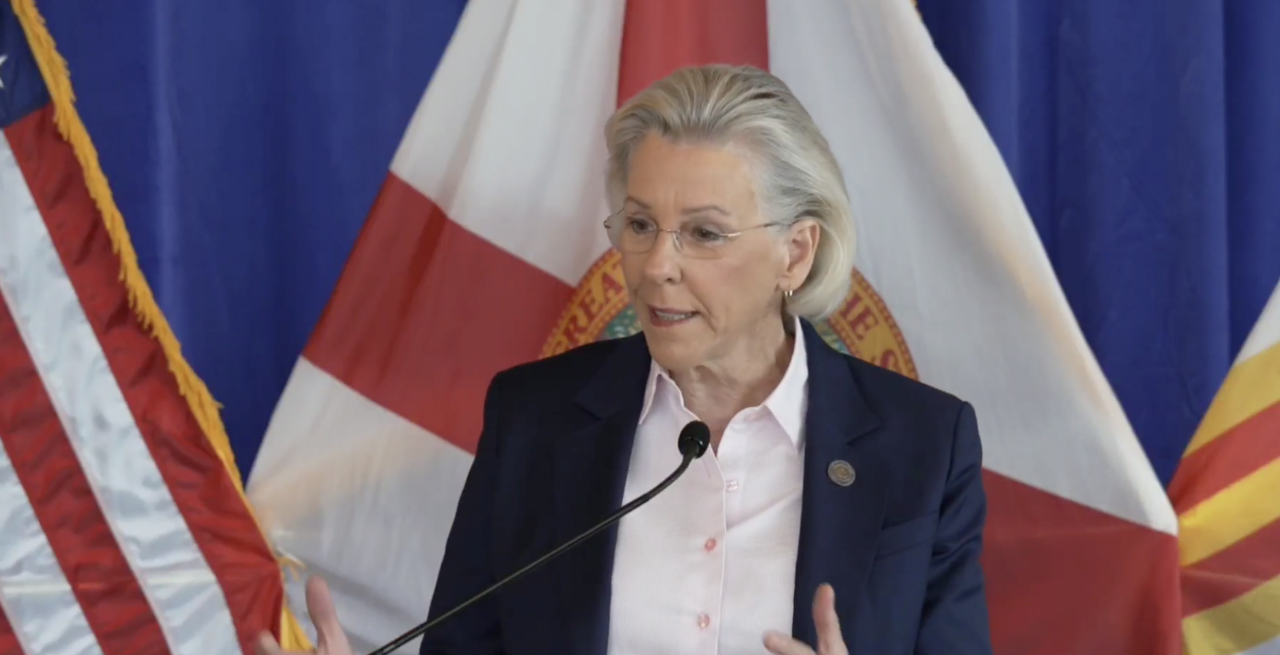
Tampa Mayor Jane Castor delivered her sixth State of the City address in front of a large crowd that included her predecessor and possible successor, Bob Buckhorn, as well as city staff, members of the City Council, supporters and stakeholders.
The predominant message — not just from Castor’s remarks, but from programming ahead of her keynote speech — was Tampa’s resilience following Hurricanes Helene and Milton last year, and its ongoing efforts to further increase that resilience.
But Castor also touted numerous wins, from transportation to development to diversity to continued income growth.
“Tampa is now the No. 1 city in the nation for women-owned businesses. That is something to celebrate,” Castor said. And, “for the first time ever, Tampa’s median household income is over $70,000 a year,” she added.
But Castor said Tampa’s success should not be measured only in numbers, but rather by the actions of neighbors.
“It’s in how we show up for each other during hard times. It’s in how we celebrate each other’s victories. It’s in how we lift each other up. Tampa’s strength is you. It’s us. It’s this community,” she said.
The city’s residents showed up for one another in the back-to-back hurricanes, Castor illustrated as photos of neighbors helping neighbors were displayed on screen. So too did the city’s public safety workers.
Castor said first responders answered nearly 200 emergency calls during Hurricane Helene, and more than 15,000 during Hurricane Milton. Among those, public safety officials rescued 52 residents and eight pets from rising waters during Helene. During Milton, they rescued 15 people trapped in a home after a tree crushed the residence.
She also touted the city’s Public Works Department for clearing streets, and the Solid Waste Department for its debris management.
“Solid Waste collected enough debris to fill the Rivergate Tower, better known as the Beer Can Building, four and a half times over,” Castor said, punctuating the feat by noting that it was done “ahead of schedule.”
She also praised the city’s communications department for keeping “residents informed, answering hundreds of calls and questions,” and every single city employee who “gave 100%,” calling for a round of applause for the entire city workforce.
“But for some neighborhoods — Davis Islands, Palmetto Beach, Westshore, Forest Hills, Overlook, Palma Ceia Pines — the devastation lingers,” Castor acknowledged. “I’ve seen the anguish and fear in the eyes of so many Tampanians ravaged by Milton and Helene, and I promise we will not be forgotten.”
Castor said the city continues to work with federal, state and local partners on recovery efforts, and noted that the city established a disaster assistance fund to help those struggling to keep up with their mortgage or other expenses as they recover.
But she also said resiliency is an ongoing effort.
“More storms are coming,” she reminded. “And they are going to be stronger, wetter and more frequent. Geography is both our greatest asset and our biggest challenge.”
That’s a reference to Tampa’s location on Florida’s peninsula that has made it an infrequent target for direct hits from storms, as conditions must be quite precise for a storm to make its way into the Gulf and make the turn into Tampa Bay.
But if a storm were to make landfall in the mouth of Tampa Bay, the results could be catastrophic.
To prepare, Castor said the city has invested $94 million in wastewater upgrades, including for 28 “critical pump stations.” She said another $350 million has been invested in stormwater maintenance and improvements.
Ahead of the year’s hurricane season, which begins in June, Castor said the city is adding backup generators to pumping stations to ensure greater resiliency. In the first quarter of this year alone, city crews have removed more than 500 tons of debris from pipes, an effort that helps reduce flooding.
She also said the city is reinforcing seawalls, modernizing the energy grid and making fuel access more efficient at Port Tampa Bay.
To those who might be frustrated with construction related to infrastructure and resiliency improvements, Castor reminds that progress is not always easy.
“Digging up roads, blocking streets, rerouting services — it’s frustrating,” she said. “But temporary inconvenience in one block means long-term protection for the entire neighborhood. Infrastructure may not be glamorous, but it’s the backbone of our safety and our future.”
Castor’s recent efforts on infrastructure are part of, or in addition to, the historic program approved under her leadership in 2019. The PIPES project is a $2.9 billion funding plan that gradually increases water and wastewater rates over 20 years to bring the city’s infrastructure in line with current needs.
The Mayor called it a “once-in-a-generation overhaul” and said so far it has led to the replacement of 62 miles of aging water lines and 209 miles of deteriorated wastewater lines. Castor said the investment is saving “millions of dollars by avoiding leaks, breaks, cave-ins, and costly repairs.”
“We’re not just fixing pipes, we’re future-proofing Tampa,” she said.
Castor also tackled transportation, a never-ending headache for residents, workers who commute into the city, and visitors.
“We’re $3 billion short on road repairs and $1 billion short on sidewalks,” she said, lamenting that “Tampanians overwhelmingly supported” the All For Transportation sales tax that was overturned by the courts.
“Losing that revenue really hurt,” she said.
But instead of caving to defeat, Castor said the city stepped up, creating two in-house paving teams, increasing street paving by more than 50% and repairing more sidewalks this year “than in the last decade combined.”
Since 2019, Castor said the city has paved over 235 miles of city streets and has added 56 miles of new bike lanes. The city’s streetcar also is being extended into Tampa Heights, which will not only offer a transit solution in the city’s urban core, but also develop new transit-oriented development opportunities.
The city has also joined the federally funded Regional Infrastructure Accelerator to speed up transportation projects, including the airport-to-downtown connection, Castor said.
“Our streetcar has gone from a tourist novelty to a daily transit solution, serving over 1.4 million projected riders this year,” she added.
Castor also addressed a huge issue facing not just Tampa, but pretty much every area across the nation: affordable housing.
“We emerged as one of America’s most attractive cities, and our growing popularity sent Tampa home prices rising more than 175% over the last decade. Our housing supply could not keep up with demand,” she said.
But progress is being made, she said, pointing to construction that kept moving during the COVID crisis and 20,000 new residential units already on the market, with “many thousands more planned or in development.”
“We’re using every tool available: accessory dwelling units, down payment and rental assistance, in-fill, zoning reform,” Castor said, noting that “rental rates are back to 2021 levels.”
Castor also highlighted growth among the city’s partners. Tampa International Airport is building an international airside that is expected to grow the airport from 25 million passengers annually to 35 million by 2037. At the port, new berths and additional cranes are on the way, with dredging to accommodate larger ships in the works.
The city is also home to Tampa General Hospital and USF Health, which she said are “setting a new national standard for health care through research, technology, and innovation, transforming our city into a true medical district.”
“This is Tampa’s moment,” Castor beamed. “We used to have to fight to get on the map, now we are shaping that map.”
As she wrapped her address, Castor touched on the political climate nationally, noting that Tampa is “a city built by immigrants and entrepreneurs, cigar rollers and tech founders, veterans and visionaries,” a poke at the immigration crackdown underway under President Donald Trump, and backed in Florida by Gov. Ron DeSantis.
“We are not divided, we are diverse,” she added. “That’s not ‘woke,’ that’s Tampa.”



